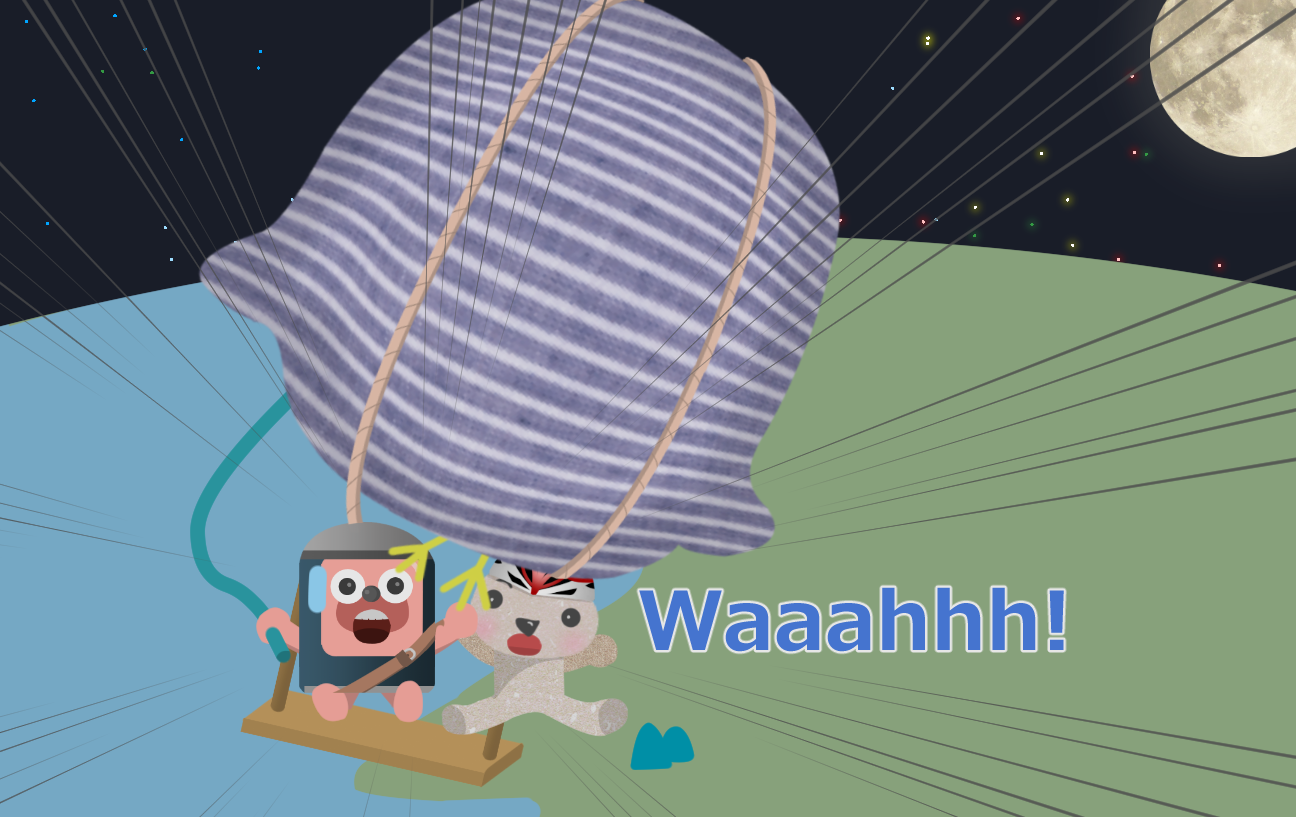ペラペラ英語飯29「鳥が凍って空気が出なくなり、落下し始める」
(前回までのあらすじ)ピットと太郎は鳥に乗って「英語飯」の看板がある山を目指しています。高度を上げすぎて寒くなったと思ったら、鳥から出ていた空気が急に止まりました。
Taro said, “Why is air not coming out!?"
Taro rubbed and pulled the tube which was placed in the bird from both directions, but there was no change. He thought that he would rub the bird’s body and touched it. He realized that the bird’s skin was very chilly and solid like an ice. It was because the thin skin of the bird was frozen by negative temperature, so an ability to shrink for gushing air was lost.
The bird which lost propulsive force to go up in the sky slowed down and began to fall down toward the ground.
“Waaahhh!"
They fell while screaming.
English specialist “IDIY AK" checked.
解説
Taro said, “Why is airnot coming out!?"
太郎「どうして空気が出ないんだ!?」
come outは「出る」という意味です。
Tarorubbed and pulledthe tubewhich was placed in the bird from both directions, but there wasno change.
訳「太郎は鳥に付いているチューブを揉んだり、引っ張ったりしましたが変化はありませんでした。」
この文は等位接続詞のbutを使って以下の2つの文を逆接でつないでいます。
⇒「等位接続詞butとは」
(A)Taro rubbed and pulled the tube which was placed in the bird from both directions.
(B)There was no change.
さらに、A文は等位接続詞のandを使って以下の2つの文を繋いでいます。
⇒「等位接続詞andとは」
(A-1)Taro rubbed the tube which was placed in the bird.
(A-2)Taro pulled the tube which was placed in the bird from both directions.
関係代名詞のwhichを使った形容詞節がtubeを修飾しています。
⇒「関係代名詞whichとは」
from both directionsは「両方向から」という意味です。from both endsでも同じ意味になります。今回の文はチューブを2つの手で持って、2つの手を離すように引っ張る(チューブを伸ばす)イメージです。
Hethoughtthat he would rub the bird’s body and touched it.
訳「彼は鳥を揉んでみようと思って鳥を触ってみました。」
従位接続詞のthatを使った名詞節が文の目的語になっています。
⇒「従位接続詞thatとは」
「~してみようと思って」は、would を使ってthought that he would~のようにします。
(例) I thought I would try once, but it was not easy.「一度挑戦してみようと思ったが、やはり簡単ではなかった。」
Herealizedthat the bird’s skin was very chilly and solid like an ice.
訳「鳥の皮は氷のようにキンキンに冷えて硬くなっているのがわかりました。」
従位接続詞のthatを使った名詞節が文の目的語になっています。
⇒「従位接続詞thatとは」
「キンキンに冷えて」は、形容詞のchillyを使います。
(例)Chilly beer 冷えたビール
Itwasbecause the thin skin of the bird was frozen by negative temperature, so an ability to shrink for gushing airwaslost.
訳「それはマイナス気温によって鳥の薄い皮が凍ったためでした、そのため、空気を吹き出すための縮む力が無くなったのです。」
従位接続詞のbecauseを使った副詞節が主節「It was」を補足しています。
⇒「従位接続詞becauseとは」
Itは前の文の「鳥の皮が冷たくて氷のように冷たい」を示す代名詞です。
becauseを使う時は通常、「A because B.」や「because B, A.」のように1つの文の中で理由と結果を言うことが多いですが、今回の文では結果と理由を2つの文に分けています。結果を言い切ったあとに、なぜならと続けたいときに使えます。例えば、先に結果を言って「え!何で」と思わせたあとに理由みたいな。
さらに等位接続詞のsoを使って以下の文を原因(凍った)⇒結果(縮む力を失った)の流れでつないでいます。
⇒「等位接続詞soとは」
(A)It was because the thin skin of the bird was frozen by negative temperature.
(B)An ability to shrink for gushing air was lost.
Bの文では不定詞を使った形容詞句「to shrink for gushing air」がabilityを修飾しています。
⇒「不定詞の形容詞用法」
形容詞句の中では動名詞を使った名詞句「gushing air」がforの目的語になっています。
⇒「動名詞とは」
The bird which lost propulsive force to go up in the skyslowed down and beganto fall down toward the ground.
訳「推進力を失った鳥は減速し、今度は地上に向かって落下を始めました。」
この文は等位接続詞のandを使って以下の2つの文を繋いでいます。
⇒「等位接続詞andとは」
(A)The bird which lost propulsive force to go up in the sky slowed down.
(B)The bird which lost propulsive force to go up in the sky began to fall down toward the ground.
関係代名詞のwhichを使った形容詞節がbirdを修飾しています。
⇒「関係代名詞whichとは」
slow downは「速度を落とす」という意味です。
propulsive forceは「推進力」という意味です。
不定詞を使った形容詞句「to go up in the sky」がforceを修飾しています。
⇒「不定詞の形容詞用法とは」
fall downは「落ちる」という意味です。
Bの文では不定詞を使った名詞句が目的語として使われています。
⇒「不定詞の名詞用法とは」
“Waaahhh!"
訳「ウワー!」
Theyfellwhile screaming.
訳「彼らは叫びながら落ちていきました。」
従位接続詞のwhile「~しながら」を使った副詞節が主節を補足しています。主節と従属節の主語+動詞が同じなので、従属節の主語+動詞を省略しています。
⇒「従位接続詞whileとは」
全文訳
太郎「どうして空気が出ないんだ!?」
太郎は鳥に付いているチューブを揉んだり、引っ張ったりしましたが変化はありませんでした。彼は鳥を揉んでみようと思って鳥を触ってみました。鳥の皮は氷のようにキンキンに冷えて硬くなっているのがわかりました。それはマイナス気温によって鳥の薄い皮が凍ったためでした、そのため、空気を吹き出すための縮む力が無くなったのです。
推進力を失った鳥は減速し、今度は地上に向かって落下を始めました。
「ウワー!」
彼らは叫びながら落ちていきました。
英語飯チェック
| 語句 | 意味 |
|---|---|
| come out | 出る |
| rub | 揉む |
| pull A from both directions | Aを両側から引っ張る |
| touch | 触る |
| realize | ~に気が付く |
| chilly | 冷ややかな |
| solid | 固い |
| thin | 薄い |
| freeze | 凍る |
| negative temperature | マイナス気温 |
| ability | 能力 |
| shrink | 縮む |
| gush | ふき出る |
| lost | 失われた |
| propulsive force | 推進力 |
| slow down | 速度を落とす |
| fall down | 落下する |
